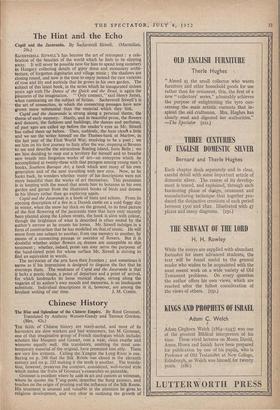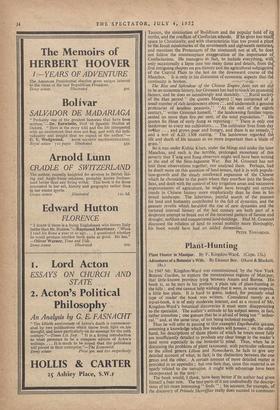Chinese . History The Rise and Splendour of the Chinese Empire.
By Rend Grousset. Translated by Anthony Watson-Gandy and Terence Gordon. (Bles. 42s.) THE fields of Chinese history are many-acred, and most of its harvesters are slow workers and bad winnowers, but M. Grousset, one of that imaginative group of French sinologues which includes scholars like Maspero and Granet, cuts a wide, clean swathe and winnows equally well. His translators, omitting the most con- temporary material of the original, have presented him ably. There are very few irritants. Calling the .Yangtse the Long River is one. Saying on p. 248 that the Silk Route was closed in the eleventh century and on p. 255 making it the tenth is another. The transla- tion, however, preserves the compact, considered, well-turried style which makes the fruits of Grousset's researches so palatable. Grousset is excellent where he calls in art and custom as witnesses, where he quotes the T'ang poets, describes the Sung painters, and touches on the origin of printing and the influence of the Silk Route. His treatment is unusual and valuable in the attention he gives to religious development, and very clear in outlining the growth of Taoism, the sinicisation of Buddhism and the popular hold or i myths, and the conflicts of Confucian schools. If he gives too mucW space to Christianity, and With characteristic bias too proud a placd to the Jesuit missionaries of the seventeenth and eighteenth centurieif and mentions the Protestants of the nineteenth not at all, he does not follow the commonplace exaggeration of the importance of, Confucianism. He managesr in fact, to include everything, witIL only occasionally a lapse into too many dates and details, from th first intriguing chapter on pre-history and the agricultural subjugatio of the C.eqtral Plain to the last on the downward course of th Manchus. It is only in his discussion of economic aspects that th continuity is broken.
The Rise and Splendour of the Chinese Empire, does not set out to be an economic history, but Grousset has had to taiach'on economi4 factors, and he does so tantalisingly and sketchily. Rutil society of the Han period " (he quotes Maspero) t,` was coMposed of small number of rich landowners above . and underneath a genuine proletariat of landless peasants." "At the end of the eighth century," writes Grousset himself, " the landowning families repre sented no more than five ,per cent. of the total population." He quotes Su Hsun of early Sung as reporting : " There is only one landowner to every ten cultivators.... The cultivator lives from day totklay . . and grows poor and hungry, and there is no remedy,", and a text of A.D. 1308 stating, " The landowner regarded the life and death of his tenants as no more important than a blade of grass."
So it was under Kublai Khan, under the Mings and under the later Manchus, and such is the terrible, prolonged monotony of this poverty that T'ang and Sung observers might well have been writing at the end of the Sino-Japanese War. But M. Grousset has not knit these observations together, nor analysed them. Perhaps, had he dwelt more on this question of land-tenure, tied it in with popula- tion-growth and the steady southward expansion of the Chinese which he chronicles to the point where they overflow into the South Seas, and dealt with the control of key irrigation areas and successive improvements of agriculture, he might have brought out certain trends in Chinese history more emphatically than he does in his broad landscape. The laborious, painful search of the peasant for land and humanity contributed to the fall of dynasties, and the peasant revolts which heralded the rise of new dynasties and the tortured internal history of the last century are both part of a desperate attempt to break out of the recurrent pattern of famine and drought, serfdom and concentrated land-holdings. Had M. Grousset discussed the relation of land to social stability more thoroughly, his book would have had an added dimension.
PETER TOWNSEND,



























































 Previous page
Previous page